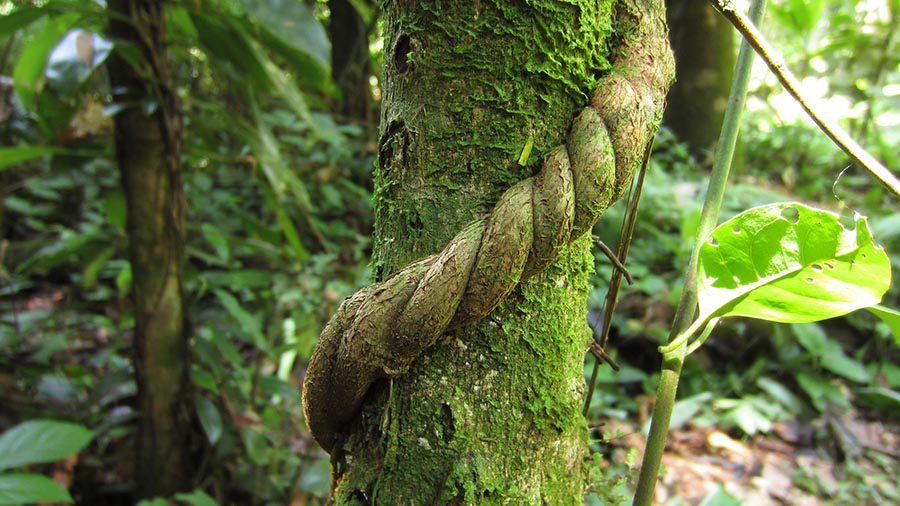What Is Ayahuasca?
Ayahuasca is a sacred tea of the Amazon, a living medicine that opens the heart, clears the body, and awakens the spirit to remember its divine nature.
Ayahuasca At a Glance
What It Is: A sacred tea (decoction) made primarily from the Banisteriopsis caapi vine and the Psychotria viridis (chacruna) leaf.
Traditional Use: Used for centuries by Indigenous peoples of the Amazon for healing, ceremony, and spiritual guidance.
How It Works: The caapi vine allows the body to feel the effects of DMT from chacruna. Together, they create a visionary and deeply connective state.
Effects: Physical cleansing, emotional release, vivid visions, profound connection, and insights into self and spirit.
In Essence: Ayahuasca is a living medicine that helps us remember our wholeness and our divine nature.
Helpful Terminology
Sacred: When something is called sacred, it means it is regarded with great respect and reverence by a community of people.
Psychedelics: Psychedelics are substances that can induce deep understanding and profound spiritual or mystical experiences—transcendence, healing, and insight—often accompanied by colorful visions, sounds, and other sensory input.
Psychoactive: Psychoactive refers to substances that affect how the brain works, bringing about changes in mood, awareness, thoughts, feelings, or behavior.
Entheogenic: Entheogenic comes from the word entheogen, meaning a substance that reveals the divine within.
Decoction: A decoction is essentially a tea that is boiled down and concentrated.
What Is Ayahuasca?
Ayahuasca is a sacred, psychedelic, psychoactive, and entheogenic decoction that has been traditionally used by Indigenous peoples throughout the Amazon basin in medicinal, spiritual, shamanic, and ceremonial healing for centuries. Today, it is utilized in many different parts of the world—ideally for the same purposes.
In other words, Ayahuasca is a traditionally revered tea that can shift the way we think, feel, and act—awakening a greater sense of health and well-being through all of our senses, while opening us to profound physical, emotional, and spiritual experiences that allow us to witness our own divine nature.
What Is Ayahuasca Made Of?
The brew of ayahuasca is generally made from two plants: Banisteriopsis caapi (often called the Ayahuasca vine) and Psychotria viridis (also known as chacruna). While traditional and non-traditional recipes may include other plants or substances, for this article we focus on this “straight” decoction, without admixtures.
Banisteriopsis caapi is a vining plant native to the Amazon rainforest. Chacruna is a shrub of the coffee family, also native to the Amazonian lowlands, and it is the source of dimethyltryptamine (DMT)—the primary psychoactive compound in Ayahuasca, according to current scientific understanding. DMT occurs naturally in all living beings, including ourselves, but the human body produces an enzyme that prevents us from feeling its full effects. Banisteriopsis caapi contains compounds that inhibit that enzyme, allowing us to experience not only our own naturally occurring DMT more fully, but also that of the chacruna plant.
Chacruna is powerfully psychedelic, producing vivid and detailed visions and states of profound connection. Caapi, on its own, generates a more subtle, dreamlike, and connective state—often accompanied by gentle visions—and is largely responsible for the cleansing and purgative effects that Ayahuasca is known for.
When combined, their gifts merge into one medicine: Caapi’s guiding wisdom holds the space, while chacruna’s light and interdimensionality illuminate the vision, together opening pathways of healing, and transformation.
“To understand their relationship within the brew, this simple analogy can help: an Ayahuasca experience is like a storybook. Caapi is the kind and wizened narrator, weaving the story that moves us and softens our hearts. Chacruna, with its DMT, is the illustrator—bringing color, depth, and vivid perception to the tale. Together, narrator and illustrator create a living book whose pages open to vision and feeling, guiding us toward wholeness and remembering.”

